Key takeaways:
- ROI analysis should encompass both financial returns and intangible benefits like brand awareness and customer engagement.
- Setting specific, measurable campaign objectives is crucial for aligning efforts with overarching business goals.
- Combining quantitative metrics with qualitative insights provides a comprehensive understanding of campaign impacts.
- Collaboration and diverse perspectives during analysis can uncover valuable insights and enhance decision-making.
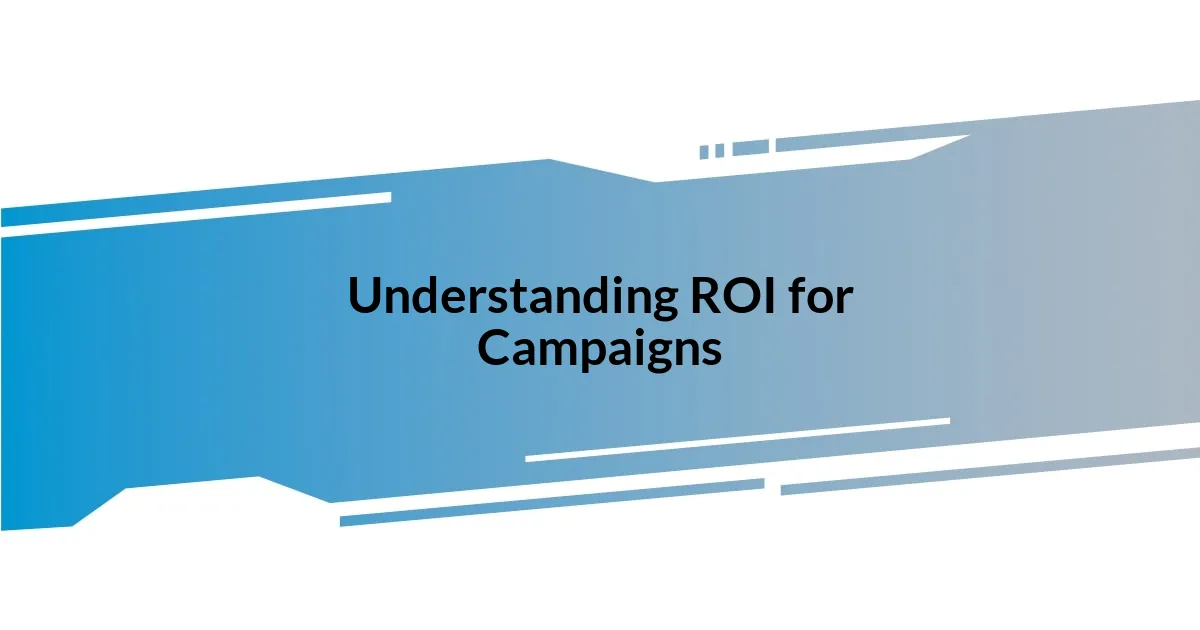
Understanding ROI for Campaigns
Understanding ROI for campaigns goes beyond just numbers; it taps into the heart of marketing strategy. I remember feeling the excitement when my team launched a campaign that promised great potential. Yet, what truly mattered was the moment we calculated our return on investment (ROI) and saw how it aligned with our goals—suddenly, that excitement was grounded in tangible results.
When examining ROI, it’s vital to consider not just the financial return but also the impact on brand awareness and customer engagement. One time, I conducted a campaign where initial sales figures showed a modest increase, but customer feedback highlighted that we established a deeper connection with our audience. Isn’t that often the real gain, even if it’s not immediately quantifiable?
How do you define success for your campaigns? For many, it’s a mix of monetary gains and the intangible aspects that enrich customer relationships. In my experience, looking at ROI through a holistic lens has often revealed insights that transformed future campaigns and solidified our marketing efforts.
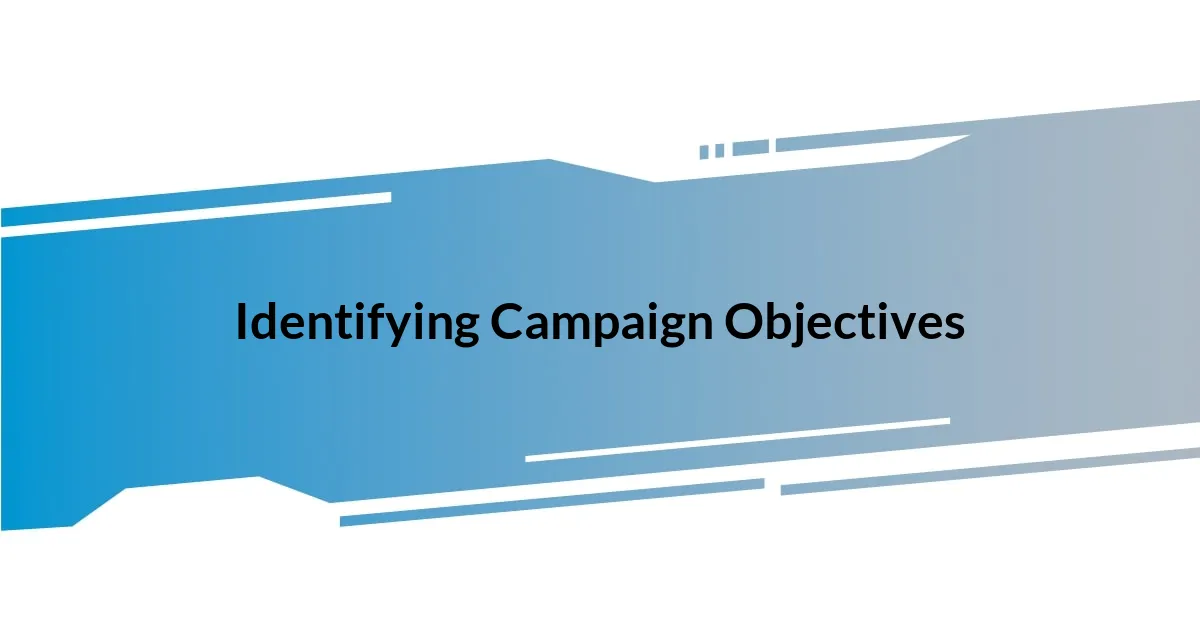
Identifying Campaign Objectives
When identifying campaign objectives, it’s crucial to tie them directly to your overarching business goals. I once had a project where we aimed to boost our email subscriptions. This goal not only increased our reach but also filled our sales funnel with fresh leads, which felt incredibly rewarding when those leads converted into loyal customers. Have you ever felt that thrill when you see your campaign objectives align perfectly with your business vision?
Every objective needs to be specific, measurable, attainable, relevant, and time-bound—commonly known as the SMART criteria. During a recent campaign, I focused on increasing engagement on social media, aiming for a 20% increase over three months. Tracking these metrics was enlightening and helped keep the team focused, showing that clarity leads to stronger campaign performance.
Sometimes, we underestimate the significance of understanding our audience when setting these objectives. In one instance, a failed campaign taught me that our target audience was misidentified. Once we recalibrated our objectives based on accurate audience insights, we watched our engagement rates soar. This experience reinforced my belief that aligning objectives with genuine audience needs is the cornerstone of successful campaigns.
| SMART Criteria | Example Objective |
|---|---|
| Specific | Increase email subscriptions |
| Measurable | Achieve 20% increase |
| Attainable | Upscale through targeted ads |
| Relevant | Align with brand goals |
| Time-bound | Within three months |
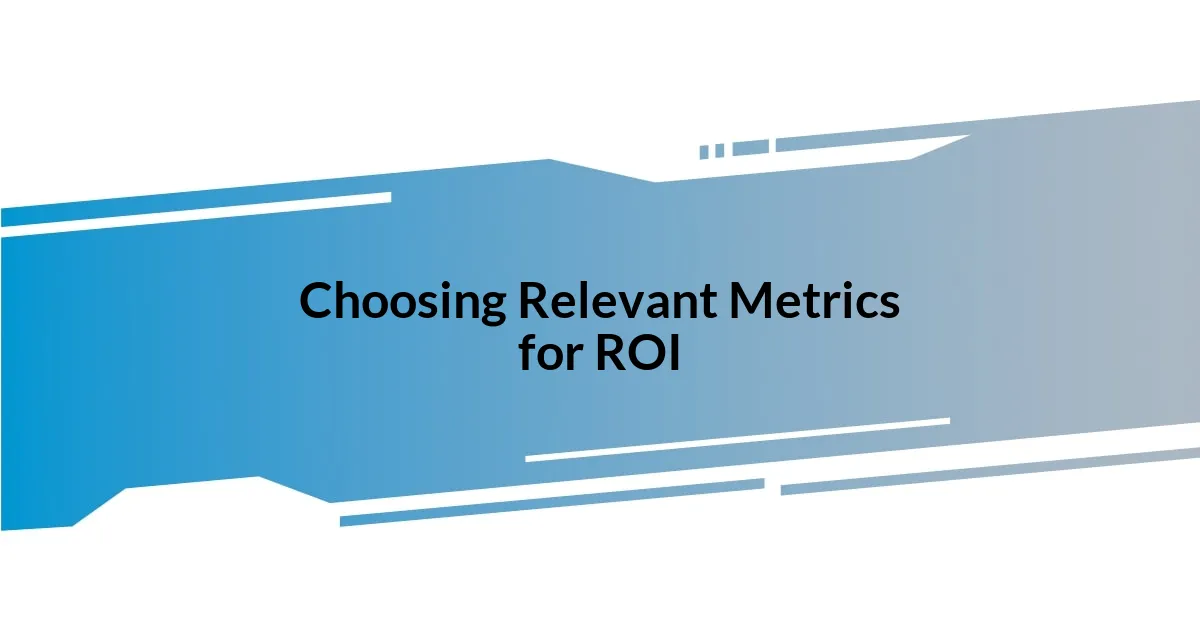
Choosing Relevant Metrics for ROI
Choosing relevant metrics for ROI is a nuanced process that requires a balance between quantitative and qualitative insights. I recall a campaign where my primary metric was sales growth, but I soon realized that tracking customer satisfaction was equally critical. This dual focus not only provided a complete picture of our success but also deepened my understanding of what our audience truly valued.
Here are some essential metrics I consider when evaluating ROI:
- Sales Revenue: Direct monetary returns from the campaign.
- Customer Acquisition Cost (CAC): Understanding how much I spend to gain each new customer.
- Customer Lifetime Value (CLV): Evaluating the long-term value a customer brings over their entire relationship.
- Engagement Rates: Metrics like likes, shares, or comments that indicate how well the message resonates.
- Brand Awareness: Tracking web traffic or social media mentions can help gauge how well my brand is being perceived.
Oddly enough, I’ve found that sometimes less traditional metrics, like customer sentiment analysis or brand perception studies, can be just as revealing. I once ran a campaign that didn’t lead to immediate sales, but the increased positive sentiment in social chatter told a different story—one that ultimately benefitted future sales. Engaging with these metrics allowed me to refine my strategies and better serve my audience.
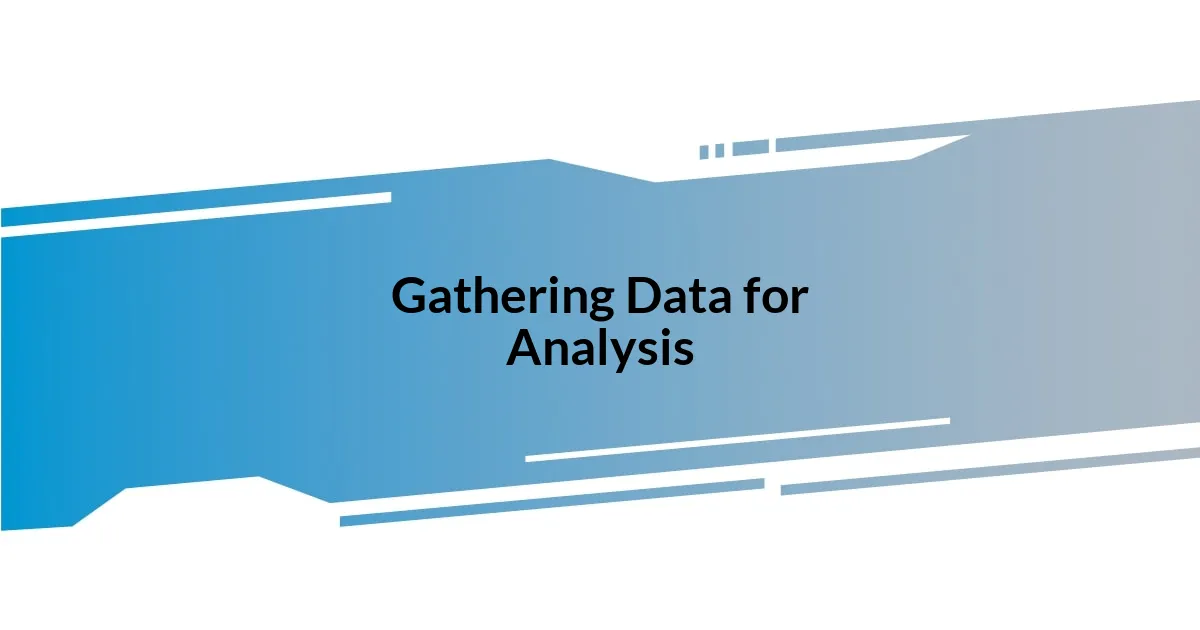
Gathering Data for Analysis
Gathering data for analysis is the backbone of measuring any campaign’s ROI. I’ve often found that the initial step is to determine the sources of data that will provide the most valuable insights. For instance, while running a recent initiative, I tapped into a mix of website analytics, social media insights, and email performance metrics. This diverse data pool gave me a more rounded perspective, allowing for a thorough analysis that went beyond surface-level results.
The real magic happens when you combine qualitative insights with the hard numbers. During a project where we explored customer feedback, I discovered that sentiment analysis revealed a treasure trove of insights. I remember reading a comment from a customer that said our product “changed their life.” This not only validated our efforts but also helped us refine our messaging in future campaigns. Have you ever felt that rush of inspiration from your audience’s feedback? It’s an invigorating reminder that behind every statistic, there are real people whose stories can shape our strategies.
I’ve learned that some of the best data often comes from unexpected places. For one campaign, I engaged with our customer service team, asking them to share common questions and concerns from our audience. Surprisingly, this informal data collection led to adjustments in our communication strategy that aligned closely with customer needs. By proactively gathering this qualitative data, I was able to make informed decisions that resonated more deeply with our audience. Isn’t it fascinating how sometimes the most insightful data comes from simply listening?
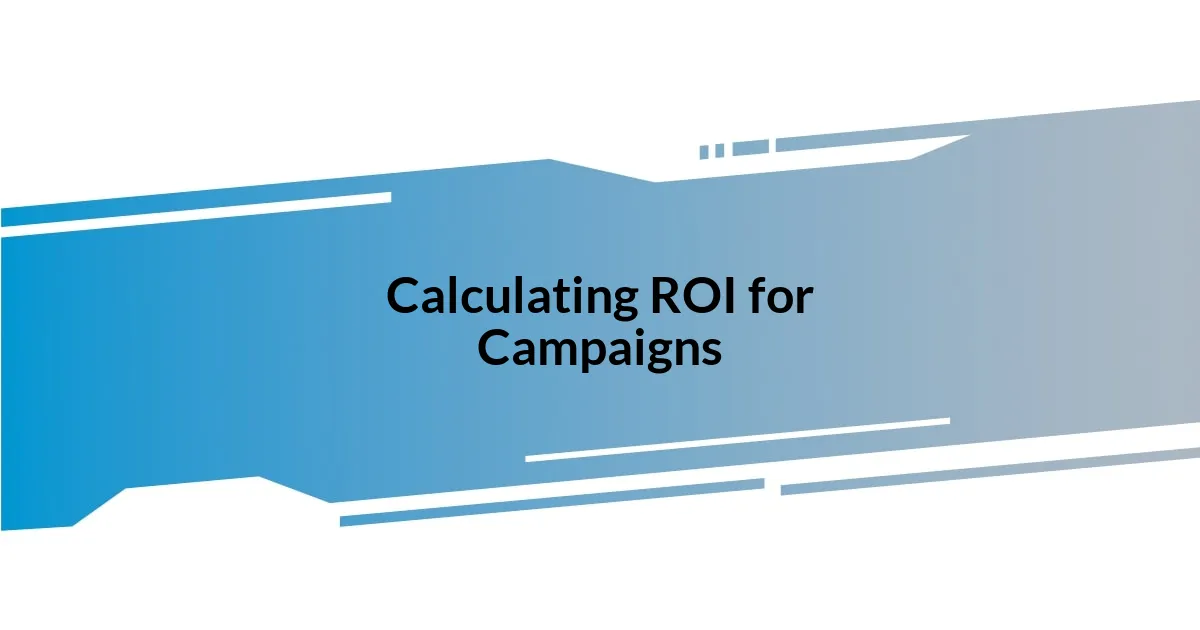
Calculating ROI for Campaigns
Calculating ROI for campaigns can feel like navigating a maze, but I’ve found it helpful to break it down into manageable steps. After a campaign, I usually start by tallying the total revenue generated and contrasting it against the costs incurred. For instance, I once managed an email marketing push that brought in $50,000, while we spent $5,000 to execute it. This gave me a clear-cut ROI of 10:1, which was undeniably impressive.
Yet, I’ve learned that simply crunching the numbers doesn’t tell the whole story. I try to go deeper by assessing the impact of our campaign on customer loyalty and retention. A campaign I conducted for a product launch led to a 15% increase in repeat purchases over the following months. It wasn’t just about the initial sales; it demonstrated that our brand resonated with customers long after the campaign ended. Have you ever thought about how a single campaign connects to an ongoing customer relationship?
In my experience, taking the time to analyze not just direct financial returns but also intangible benefits can reveal surprising insights. For example, during a recent social media campaign, we noticed a spike in brand mentions and positive engagement. While we didn’t hit our sales target immediately, this heightened brand awareness set a foundation for future initiatives. I’ve come to realize that looking at the bigger picture allows me to measure the true ROI beyond dollar signs, capturing the essence of how a campaign shapes my brand’s trajectory.
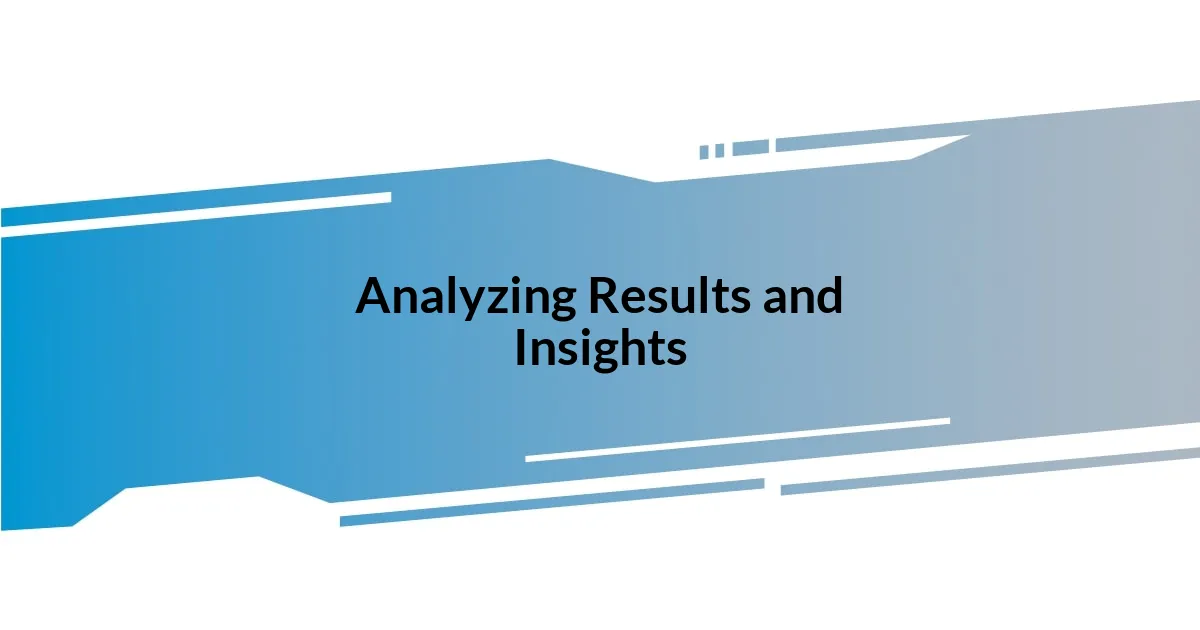
Analyzing Results and Insights
Analyzing results and insights is where the real learning begins. I once conducted a campaign geared towards promoting a new service, and in my analysis, I focused not just on sales figures but also on customer engagement metrics. I was surprised to see that even though our sales were modest, the conversations sparked on social media were on fire. It made me wonder—how often do we overlook the power of community interactions in favor of mere sales numbers?
As I sifted through the data, patterns began to emerge that told a compelling story. For example, I vividly remember spotting a correlation between our email open rates and the sentiment expressed in our feedback surveys. This insight shaped my approach; it was clear that when we communicated authentically, our audience responded more positively. Isn’t it interesting how sometimes it’s the subtler metrics, like emotional connection, that lead to lasting impact?
Moreover, I consistently find that collaboration enhances insights. In one analysis session, I invited team members from various departments to share their perspectives. This led to a fascinating debate on audience perceptions, which illuminated aspects of our brand I hadn’t considered. It was a reminder that data is best interpreted through multiple lenses, and sometimes the best insights come when we’re open to diverse viewpoints. How do you incorporate team input in your analyses, and have you found it changes the outcomes? I certainly have!